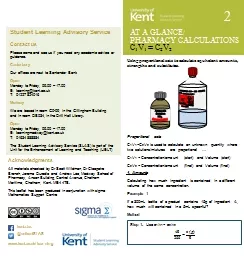

Using proportional sets to calculate equivalent amounts strengths and substitutes 20 2 3 4 AT A GLANCE PHARMACY CALCULATIONS C 1 V 1 C 2 V 2 2 Proportional sets C 1 V 1 C 2 V 2 is used to calculate an unknown quantity where two solutionsmixtures are proportional ID: 763860
Download Presentation The PPT/PDF document "Using proportional sets to calculate equ..." is the property of its rightful owner. Permission is granted to download and print the materials on this web site for personal, non-commercial use only, and to display it on your personal computer provided you do not modify the materials and that you retain all copyright notices contained in the materials. By downloading content from our website, you accept the terms of this agreement.
Using proportional sets to calculate equivalent amounts, strengths and substitutes. 20 2 3 4 AT A GLANCE/ PHARMACY CALCULATIONS C 1 V 1 = C2V2 2 Proportional sets C 1V1=C2V2 is used to calculate an unknown quantity where two solutions/mixtures are proportional … C1V1 = Concentration/amount (start) and Volume (start) C2V2 = Concentration/amount (final) and Volume (final)1. AmountsCalculating how much ingredient is contained in a different volume of the same concentration.Example 1If a 300mL bottle of a product contains 15g of ingredient A, how much will contained in a 5mL spoonful?Method Step 1: Use c1/v1= c2/v2 Student Learning Advisory Service Contact usPlease come and see us if you need any academic advice or guidance.CanterburyOur offices are next to Santander BankOpenMonday to Friday, 09.00 – 17.00E: learning@kent.ac.uk T: 01227 824016MedwayWe are based in room G0-09, in the Gillingham Buildingand in room DB034, in the Drill Hall Library.OpenMonday to Friday, 09.00 – 17.00E: learningmedway@kent.ac.uk T: 01634 888884The Student Learning Advisory Service (SLAS) is part of theUnit for the Enhancement of Learning and Teaching (UELT) www.kent.ac.uk/learning kent.slas @ unikentSLAS Acknowledgments All materials checked by Dr Scott Wildman, Dr Cleopatra Branch, Jerome Durodie and Andrew Lea, Medway School of Pharmacy, Anson Building, Central Avenue, Chatham Maritime, Chatham, Kent. ME4 4TB.This leaflet has been produced in conjunction with sigma Mathematics Support Centre
Step 1: Use c1 x v 1= c2 x v2 Step 2: Transpose for x and solve 2. Equivalent Strengths Converting from one measure of strength to another.Example 1What is 1 part in 20 expressed as a percentage?Method Step 1: Use c1/v1= c2/v2 Step 2: Transpose for x and solve Example 2What is 0.25% expressed as a ratio strength?Method Step 1: Use c1/v1= c2/v2 Step 2: Transpose for x and solve Example 2 If a 15mL dose of a product contains 300mg of ingredient B, how much will be contained in 500mL ? Method Step 1: Use c 1 /v 1 = c 2 /v 2 Step 2: Transpose for x and solve 3. Substitute Quantities Calculate the quantity of a concentration needed to produce a different final desired concentration and volume (a serial dilution). Example 1 How much 10% solution is needed to make up 500mL of a 2% solution? Method NB: In this case we use C 1 x V 1 = C 2 x V 2 Step 2: Transpose for x and solve Example 2 How much 5% solution is needed to make up 80ml of a 0.4% solution? Method Step 1: Use c 1 x v1= c2 x v2 Step 2: Transpose for x and solve